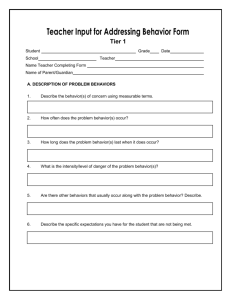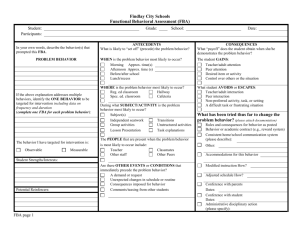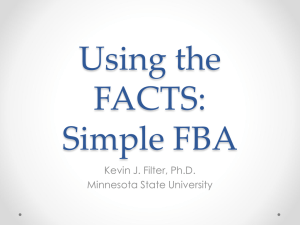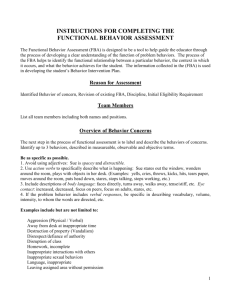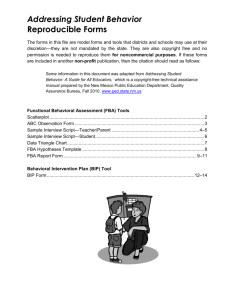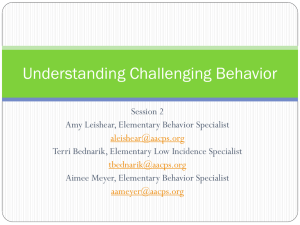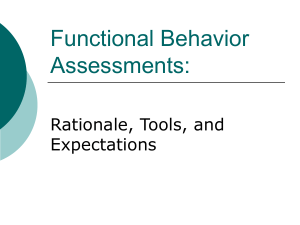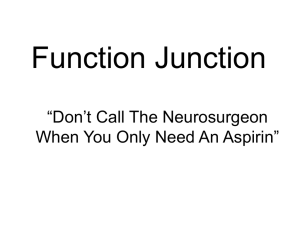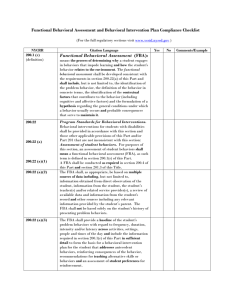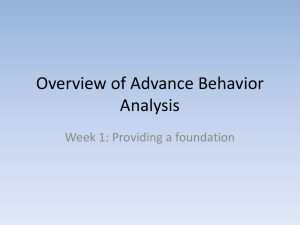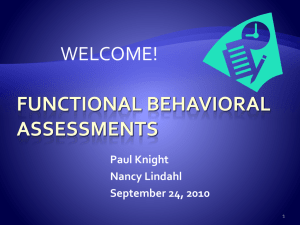FBA and BIP for Middle School
advertisement
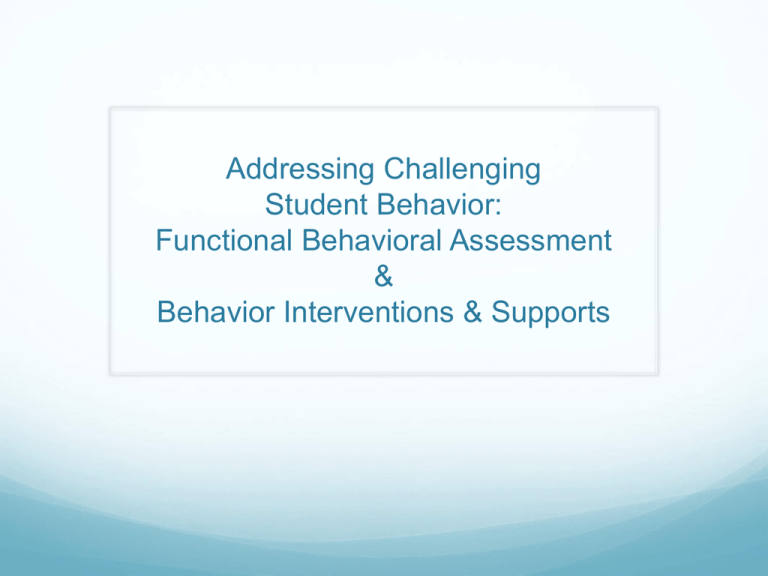
Addressing Challenging Student Behavior: Functional Behavioral Assessment & Behavior Interventions & Supports Functional Behavior Assessment (FBA) The process of gathering information about how and when specific behaviors occur for a child to help determine the reasons for the behavior and subsequently provides information that leads to interventions and supports The assumption is that by understanding the relationships we can develop behavior support plans that (a) will be more effective, (b) will be more efficient, and (c) will produce broader change in the individual with problem behaviors. Rationale for Functional Behavioral Assessment The majority of student behavior is purposeful. Behavior (appropriate and inappropriate) is related to the context(s) in which it occurs. Behavior is influenced by past-to-present events. It serves a predictive function. When do we do this….Best PRACTICES! Advantages of FBA Increases understanding of the causes of behavior; Facilitates hypothesis-driven treatment; Emphasizes skill building--not punishment Increases chance of positive student outcomes Factors to Consider Before Initiating an FBA 1. Amount of time teacher is engaged in direct instruction. 2. Amount of time student of concern is actively engaged in instruction. 3. The number of student opportunities and percentage of correct responses to instruction. 4. The quantity and quality of positive feedback given to the student. ERASE Principles That Guide FBA We can’t fix it until we know why it’s broken. One size does not fit all. No one gives up something for nothing. So What Test If your feeling about the behavior is “so what,” then it may not warrant an FBA; other behavior may take priority. ABC’s of Understanding Chronic Behavior Patterns What happens before (A or antecedent) the behavior occurs? What is the behavior (B)? What happens after (C or consequence) the behavior occurs? ABC FBA Terminology Antecedents Behavior Consequences (Outcome/Function) B A Setting Events Immediate Environmental factors that influence behavior, not immediate Appropriate Behavior or or Slow Triggers Problem Behavior C Fast Triggers Occur immediately before a behavior Goal: Goal: Access Power/control Attention Acceptance Decrease Acquire skill & Increase Affiliation Gratification Justice/revenge Protection Etc. Reinforcement Punishment Avoid/Escape Tasks Consequences Individuals Stress/anxiety Activities Symptoms Etc. Learning & ABC A In reading class, student is asked to read the word aloud on the board B student tries, but reads slowly, struggles, and gets the word wrong C peers laugh at the student and one students says, “That word is so easy” NEXT DAY….What did the student learn? Student is asked to read the word aloud on the board What happens today??? Reinforcing Consequence A B C Rewarding or Desired Consequence If the consequence is rewarding/desired, the student learns the behavior is functional for getting what they want Behavior Increases in the Future Learning & ABC A When ‘unlucky girl’ comes to table with ‘cool’ peers and student wants attention B C student makes fun of peers will laugh and student gets desired ‘unlucky girl’ attention NEXT DAY….What did the student learn? When ‘unlucky girl’ comes to table with ‘cool’ peers and student wants attention What happens today??? Behavior was rewarded – more likely to occur in future Learning & ABC A When sitting at the lunch table with group of ‘cool’ peers B Student tries to get their attention appropriately by offering to share C peers ignore student and don’t respond – student does not get desired attention NEXT DAY….What did the student learn? When sitting at the lunch table with group of ‘cool’ peers What happens today??? Behavior is punished – less likely to occur in future Focus on what we can Change We cannot prescribe medication We cannot change the students previous experiences We often cannot change the parenting practices in the home We cannot always just “add an assistant” We cannot just change placement Some venting is good, but too often it takes over leading to less productive meetings, instruction & supports for students There is a LOT we can do in the classroom to change student problem behavior This starts with student learning and structuring the environment…… ERASE Prompt ERASE is an acronym for Explain, Reason, Appropriate, Support, and Evaluate Develop a prompt sheet to be duplicated and distributed to every teacher Provides generic set of questions to be considered by referring staff or by others on the FBA team prior to attending IEP meeting E…EXPLAIN What is the problem? Create an operational definition of behavior Describe why is it a problem Determine whether he/she engage can in appropriate behavior List what have you already tried? R...REASON What is he/she getting out of or getting away from? Determine what times, locations, contexts, conditions, etc. tend to predict or precede: problem behavior appropriate behavior Determine what types of events tend to follow behavior? peers, instruction, consequences, etc. after problem behavior after appropriate behavior Make a guess at the function – why do you think he/she is doing this? access to . . . (persons, objects, attention, etc.) escape or avoid . . . (persons, activities, attention, etc.) A…APPROPRIATE What do you want him/her to do instead? Determine what times, locations, contexts, conditions, etc. tend to predict or precede: fair pair – incompatible with problem (can’t do at same time) functional – meets the same function as problem behavior S…SUPPORT How can you help this happen more often? Determine how the replacement behavior and intervention plan will be taught Rules (what it is and -- when, where, how, and why to use behavior) Examples (modeling and use of naturally occurring examples) Practice (opportunities to practice with teacher feedback) Consider realistic routines and physical arrangements that could be implemented to facilitate student success (avoid predictable failure and create success opportunities) prompts and reminders supervise avoid spoilers Determine appropriate consequences for replacement and problem behaviors – and consider what is realistic for you to do reinforcement (matches function) correction (how might this happen?) negative consequences (matches function) natural (try to keep it as realistic as possible) E…EVALUATE How will you know if it works? Consider realistic strategies for measuring behavior keep it simple consider times and conditions where measurement would be particularly meaningful and realistic Consider what your measure will look like when the behavior is no longer a problem measurable behavior by what time should this happen? Behavior Form – Create Online http://www.jimwrighto nline.com/php/tbrc/tbr c.php Our failure often rests with the fact that we do not ask the next question…why? Einstein Remember: Fair pair rule The fair pair rule states that for every behavior targeted for reduction, there should be a corresponding behavior targeted for positive reinforcement. You can not take a tool away without giving one back that fulfills the same need or function. Four Considerations for Building Behavior Support Plans 1. Indicate how staff, family, or support personnel will change and not just focus on how the person of concern will change 2. Plan should be directly based on the functional assessment information 3. Plan should be technically sound Consistent with principles of behavior analysis 4. Plan should be a good fit with the values, resources, and skills of the people responsible for implementation Behavior Support Plans Should Fit the Setting Fit the natural routines of the setting Be consistent with the “values” of the people in the setting (they need to indicate a willingness to perform the procedures) Be efficient in terms of time, money, and resources Be matched to the skills of the people who carry out the procedures Produce reinforcing (not punishing) short-term results Behavior Plans Include Positive Strategies Program or Curricular Modifications Supplementary aids and Supports to address disruptive behaviors in question ~ Use the data collected to determine the discrepancy between the student’s actual and expected behavior Behavior Plans Include (cont’d) Emphasize SKILL building Interventions based on teaching…not control Plans based on control fail to generalize Suppressing behaviors results in the student manifesting behaviors in an alternative and inappropriate manner When a student struggles academically, we look for instructional solutions. We should take the same approach for behavior problems. Prioritize the Behaviors to Target Destructive or Potentially dangerous E.g. head banging, hitting or biting Interfere with learning E.g. out of seat, talking out, or noncompliance Sets the child apart socially E.g. picking nose, obsession on topics, hygiene The best way to address undesirable behavior… …is to prevent it from happening in the first place! SUMMARY: Designing Behavior Plans Manipulate the antecedents and/or consequences of the behavior Teach more acceptable replacement behaviors that serve the same function as the inappropriate behavior Implement changes in curriculum and instructional strategies Modify the physical environment Monitor the Faithfulness of Implementation of the Plan Maintaining the integrity of the plan in ESSENTIAL! Must reach agreement to consistently apply all aspects Identify any training and resources needed to implement plan. Develop an action plan that includes specific objectives/ activities, persons responsible, and time lines. Monitor implementation to insure accuracy and consistency (e.g., scripts, checklists, narrative reports). Evaluate Effectiveness of the Behavior Intervention Plan Objective information on intervention plan/support includes: - decrease in problem behavior; - increase in replacement behaviors; - achievement of broader goals; and, - durability of behavior change across time and settings. Reasons to Modify a Plan The student has reached his/her behavioral goals & objectives. There is a change in student placement. The original intervention plan is not producing positive changes. ONLINE RESOURCES http://instech.tusd.k12.az.us/Core/Behavioral_Goals.do c INTERVENTIONS ON-LINE!! http://www.interventioncentral.org/index.php#ideas
